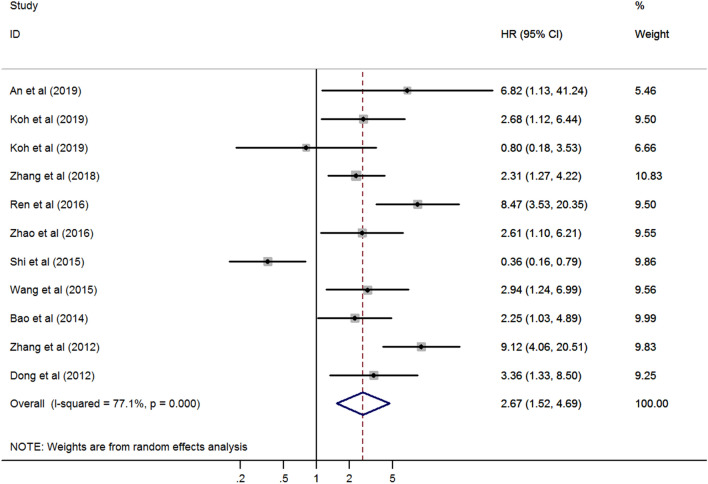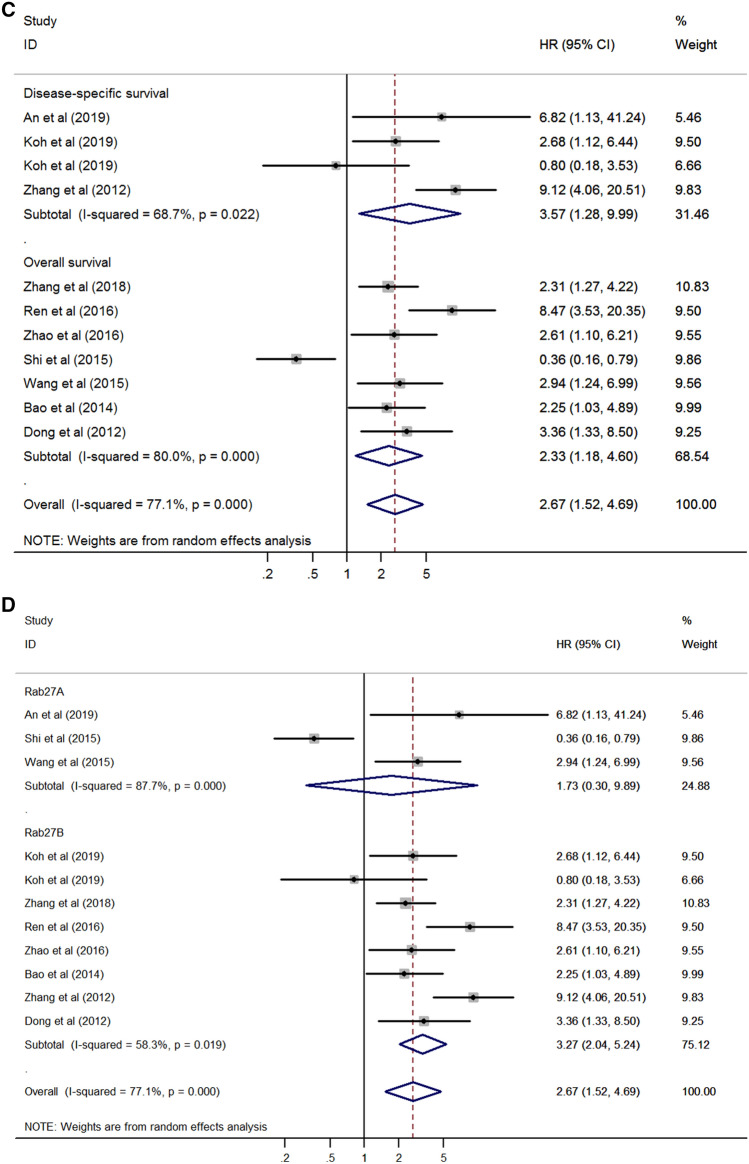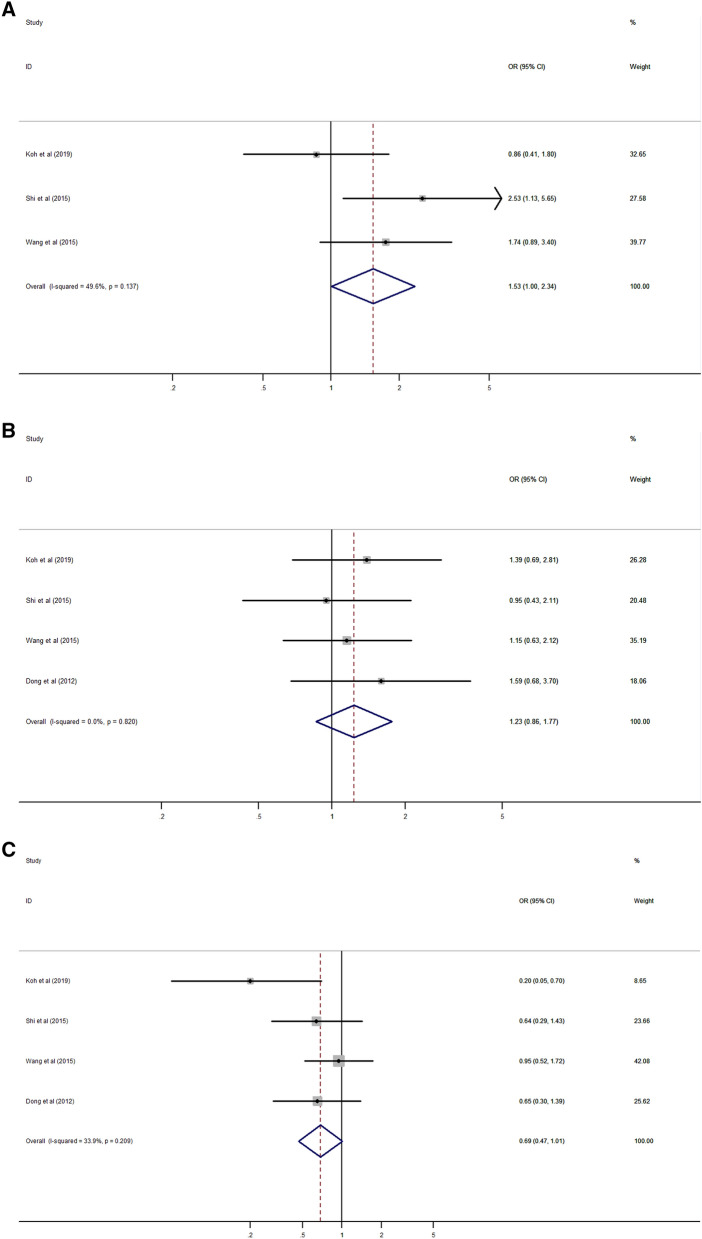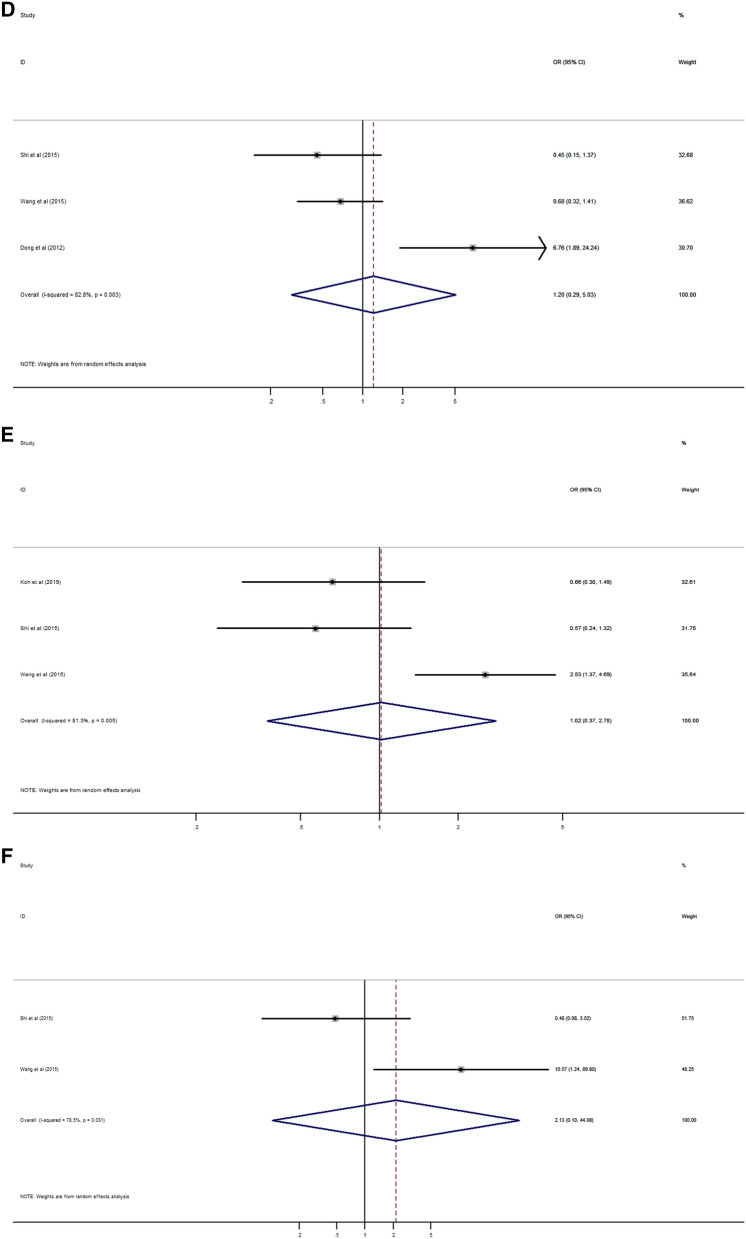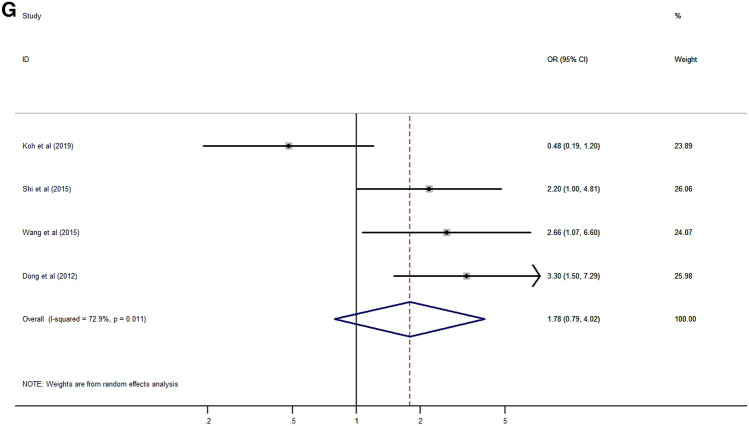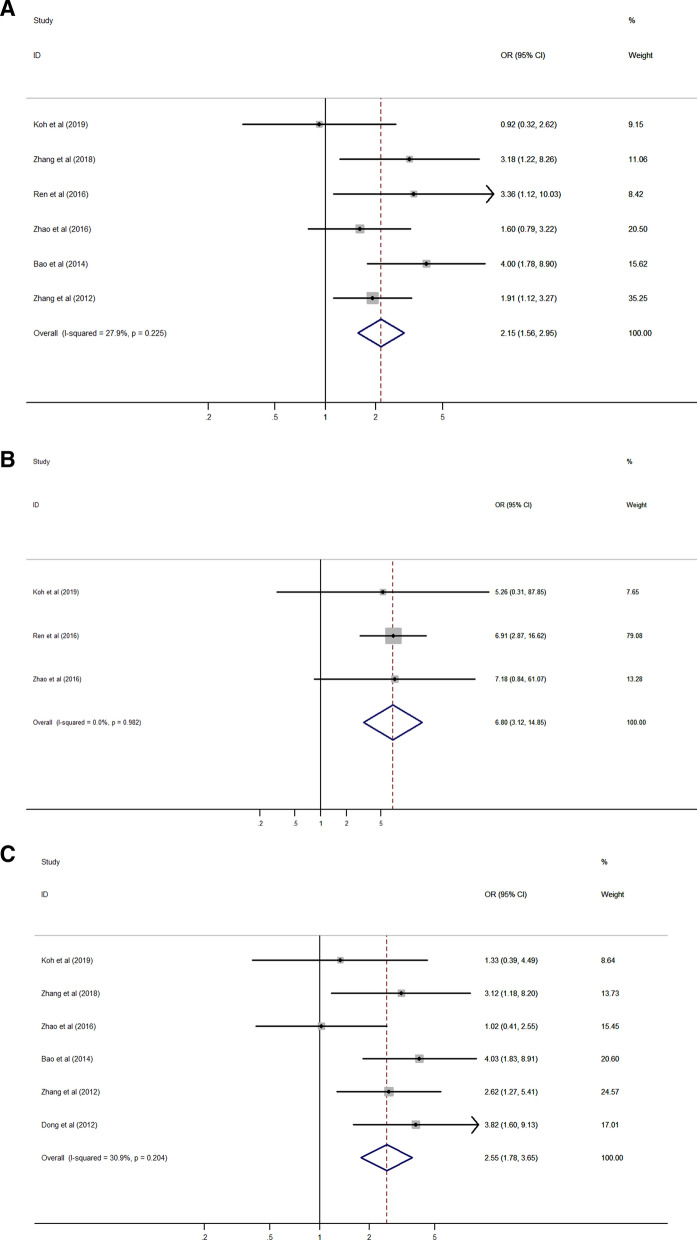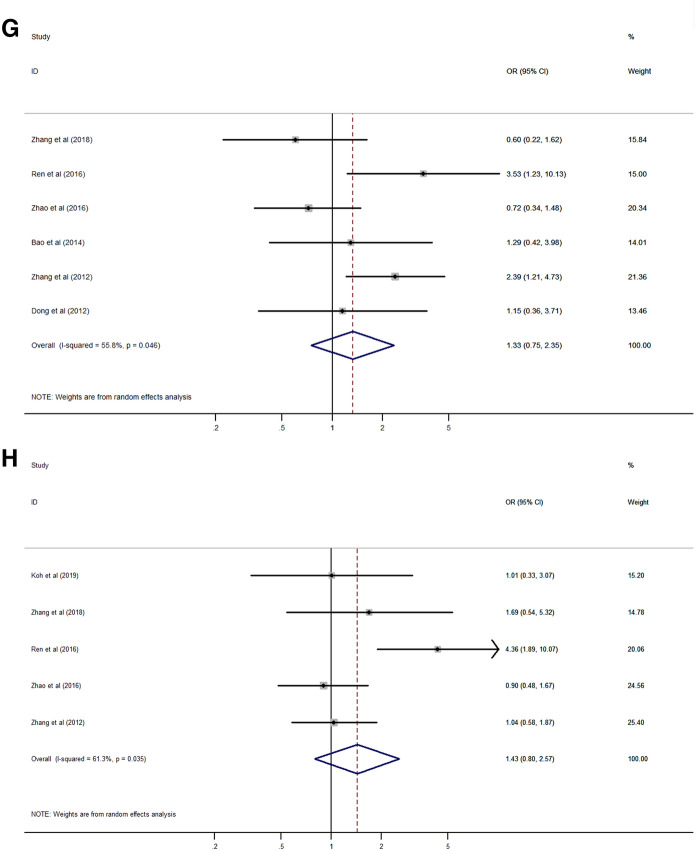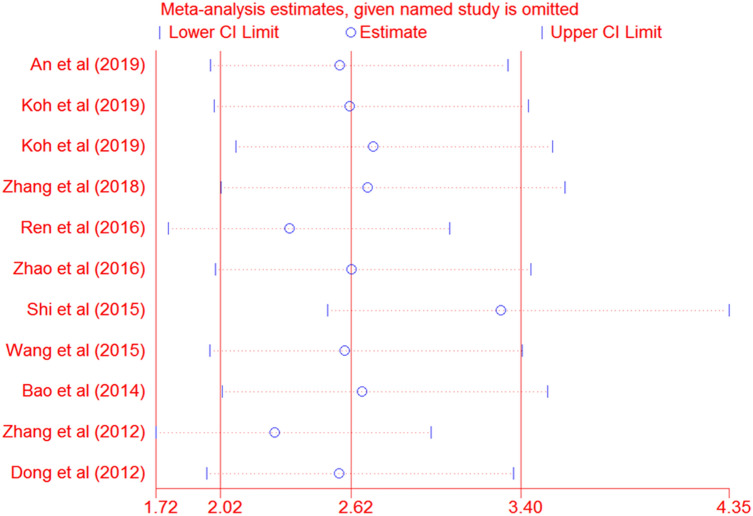Abstract
Rab27 is an essential molecule of vesicle fusion and trafficking in exosome secretion process, which plays important roles in cancer progression and metastasis. Recent studies reported that Rab27 expression is also associated with cancer prognosis. Therefore, we performed a meta-analysis to reveal the prognostic significance of Rab27 expression in solid cancer. Data were extracted by searching on PubMed, Embase and Cochrane library until February 15 2020. Pooled hazard ratio (HR) with confidence interval (CI) was calculated to evaluate the association between Rab27 expression and survival in solid cancer. Ten studies with 1434 cancer patients were including for this meta-analysis. High expression of Rab27 was associated with poor survival (HR 2.67, 95% CI 1.52–4.69, p = 0.001). High expression of Rab27A was significantly associated with lymph node metastasis (HR 1.53, 95% CI 1.00–2.34, p = 0.048). High expression of Rab27B was significantly correlated with lymph node and distant metastasis (HR 2.15, 95% CI 1.56–2.95, p < 0.001; HR 6.80, 95% CI 3.12–14.85, p < 0.001), and higher TNM stage (HR 2.55, 95% CI 1.78–3.65, p < 0.001). This meta-analysis revealed that Rab27 expression could be a potential prognostic marker in solid cancer.
Subject terms: Tumour biomarkers, Prognostic markers
Introduction
Cancer is a common cause of morbidity and mortality throughout the world1. In 2018, more than 18 million new cancer patients were occurred and 9.5 million died2. In spite of desperate development of new remedies in recent years, the prognosis of cancer remains bleak3. Therefore, recognition of new biomarkers related to the progression of cancer is essential for improving clinical outcomes4.
Rab proteins are small GTPases consisting more than 70 members in human and work as regulators of proteins trafficking, membrane focusing and fusion, and vesicles transportation, which is one of the processes to control the functioning of cells, including cell proliferation, signal communication and protein transportation5,6.
Rab27 is one of the Rab proteins and is made of two components, Rab27A and Rab27B in vertebrates6. Rab27A and Rab27B are expressed in many kinds of secretory epithelial cells and are the essential substances of vesicle trafficking and fusion in the process of exosome secretion, which is known to play significant roles in the progression and metastasis of cancer by controlling the microenvironment of cancer7–19. Moreover, recent studies reported that Rab27A and Rab27B expression are related with the prognosis of cancer8,20–28.
However, the prognostic significance of Rab27 expression is not yet understand systematically in cancer. Therefore, we performed a comprehensive meta-analysis to estimate the prognostic significance of Rab27 expression in solid cancer.
Results
Study characteristics
The literature selection flow of the included studies was presented in Fig. 1. Ten studies including 1434 patients were chosen for our meta-analysis. The basic characteristics of included studies were summarized in Table 1. All studies were published between 2012 and 2019 and were processed in Asia. The included studies were consisted of seven types of cancers, including renal cell carcinoma (n = 1), lung cancer (n = 2), ovarian cancer (n = 1), pancreatic cancer (n = 2), colorectal cancer (n = 2), breast cancer (n = 1), and hepatocellular carcinoma (n = 1). All studies performed immunohistochemistry to evaluate Rab27A or Rab27B expression in the human cancer tissue, and the majority of the cut-off value were scoring system using staining intensity and proportion. The Newcastle-Ottawa Scale (NOS) score is 7 to 8, which is considered to be high quality studies.
Figure 1.
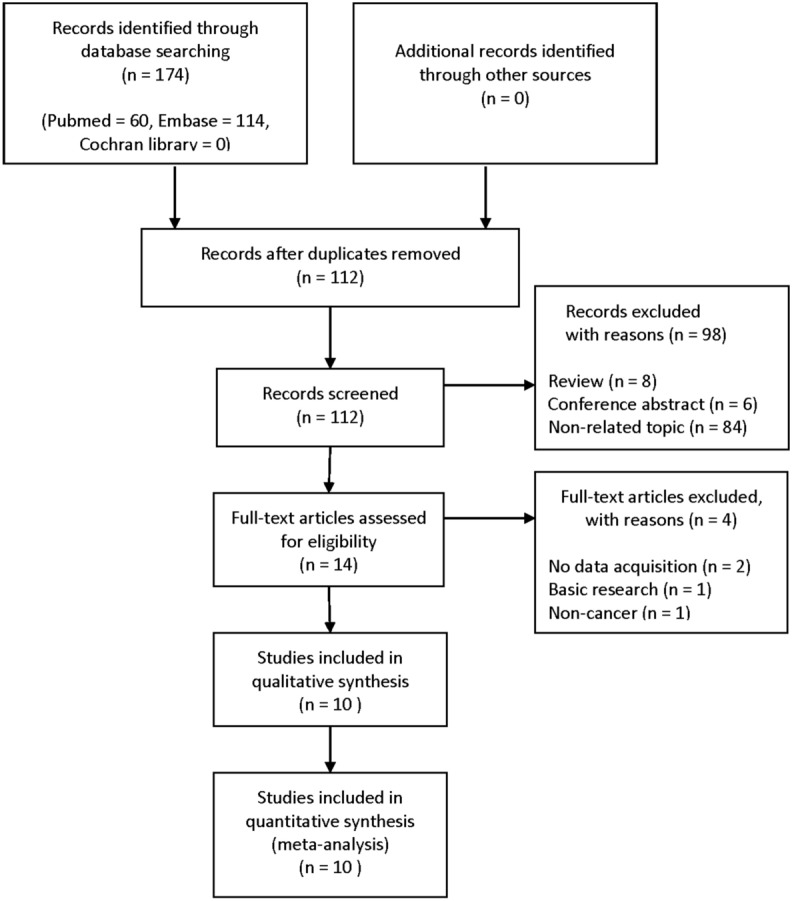
Flow diagram of study selection.
Table 1.
Basic characteristics of the included studies.
| Study | Country | Cancer type | Sample size | Gender (M/F) | Mean age (years) | Study period | Follow-up (months) | Survival outcome | Rab27 detection | Rab27 associated with prognosis | Cut-off value of Rab27 expression | Survival analysis | NOS |
|---|---|---|---|---|---|---|---|---|---|---|---|---|---|
| An et al.23 | South Korea | Clear cell renal cell carcinoma | 152 | 109/43 |
59.9 (32–83) |
2000–2009 | Mean 51.96 | DSS | IHC | Rab27A | Moderate and strong intensity (> 1 +) | MVA | 8 |
| Koh et al.26 | South Korea | Non-small cell lung cancer | 133 | 111/22 |
Median 66 (31–77) |
2002–2009 | NA | DSS | IHC | Rab27B | > 30%, stronger than internal control | MVA | 7 |
| Zhang et al.28 | China | Lung adenocarcinoma | 80 | 44/36 | NA | NA | NA | OS | IHC | Rab27B | High expression (≥ 3) | MVA | 7 |
| Ren et al.20 | China | Ovarian cancer | 103 | 0/103 | NA | 2004–2013 | NA | OS | IHC | Rab27B | Staining scores with intensity and proportion (≥ 4.5) | MVA | 7 |
| Zhao et al.8 | China | Pancreatic cancer | 186 | 99/70 | NA | 2000–2010 | NA | OS | IHC | Rab27B | Staining scores with intensity and proportion (≥ 91) | MVA | 7 |
| Shi et al.22 | China | Colorectal carcinoma | 112 | 73/39 | 65.14 | 2003–2008 | NA | OS | IHC | Rab27A | Staining scores with intensity and proportion (≥ 4) | MVA | 7 |
| Wang et al.26 | China | Pancreatic cancer | 186 | 110/76 | NA | 2003–2010 | NA | OS | IHC | Rab27A | Staining scores with intensity and proportion (≥ 91) | MVA | 7 |
| Bao et al.24 | China | Colorectal cancer | 113 | 73/40 | 65.2 | 2006–2008 | NA | OS | IHC | Rab27B | Staining scores with intensity and proportion (≥ 4) | MVA | 7 |
| Zhang et al.27 | China | Breast cancer | 221 | 0/221 | 47 | 2000–2002 | Median 79 (60–112) | DSS | IHC | Rab27B | Staining scores with intensity and proportion (> 3) | MVA | 8 |
| Dong et al.21 | China | Hepatocellular carcinoma | 148 | 108/35 | 51.6 (29–72) | 2005–2009 | NA | OS | IHC | Rab27B | Positive expression | MVA | 7 |
DSS disease-specific survival, IHC immunohistochemistry, MVA multivariate analysis, NA not available, NOS Newcastle–Ottawa Scale, OS overall survival.
Association between Rab27 expression and survival
Ten studies including 1434 cancer patients reported the association between Rab27 expression with survival. The pooled HR was evaluated using random-effects model. High expression of Rab27 was associated with poor survival (Hazard Ratio [HR] 2.67, 95% confidence interval [CI] 1.52–4.69, p = 0.001) although with heterogeneity (I2 = 77.1%, p < 0.001) (Fig. 2).
Figure 2.
Forest plot of the association between Rab27 expression and survival.
Subgroup analysis was performed to investigate the potential source of heterogeneity and revealed that cancer type, sample size, survival outcomes, and protein type could be the main sources of heterogeneity (Table 2). According to the stratification by cancer type, the result of poor survival in patients with high expression of Rab27 was consistently identified in lung cancer (HR 2.17, 95% CI 1.36–3.47, p = 0.001) and pancreatic cancer (HR 2.77, 95% CI 1.50–5.11, p = 0.001) except colorectal cancer (HR 0.90, 95% CI 0.15–5.44, p = 0.911) (Fig. 3A). Based on the sample size, poor survival was correlated to Rab27 expression in both groups (sample size more than 100, HR 3.07, 95% CI 1.42–6.65, p = 0.004; sample size fewer than 100, HR 2.17, 95% CI 1.36–3.47, p = 0.001) (Fig. 3B). On the analysis of survival outcomes, there was significant relationship between Rab27 expression and poor survival in both groups (disease-specific survival, HR 3.57, 95% CI 1.28–9.99, p = 0.015; overall survival, HR 2.33, 95% CI 1.18–4.60, p = 0.015) (Fig. 3C). When it comes to the protein type, there was a significant result in Rab27B (HR 3.27, 95% CI 2.04–5.24, p < 0.001), but not in Rab27A (HR 1.73, 95% CI 0.30–9.89, p = 0.538) (Fig. 3D).
Table 2.
Subgroup analysis of the association between Rab27 expression and survival.
| Subgroup | Number of studies | Number of patients | Pooled HR (95% CI) | p value | Heterogeneity | |
|---|---|---|---|---|---|---|
| I2 (%) | p value | |||||
| Cancer type | ||||||
| Colorectal cancer | 2 | 225 | 0.90 (0.15–5.44) | 0.911 | 90.3 | 0.001 |
| Lung cancer | 2 | 213 | 2.17 (1.36–3.47) | 0.001 | 0.0 | 0.369 |
| Pancreatic cancer | 2 | 372 | 2.77 (1.50–5.11) | 0.001 | 0.0 | 0.850 |
| Others | 4 | 624 | 6.67 (4.11–10.80) | < 0.001 | 0.0 | 0.398 |
| Sample size | ||||||
| Fewer than 100 | 2 | 213 | 2.17 (1.36–3.47) | 0.001 | 0.0 | 0.369 |
| More than 100 | 8 | 1221 | 3.07 (1.42–6.65) | 0.004 | 82.8 | < 0.001 |
| Survival outcome | ||||||
| DSS | 3 | 506 | 3.57 (1.28–9.99) | 0.015 | 68.7 | 0.022 |
| OS | 7 | 928 | 2.33 (1.18–4.60) | 0.015 | 80.0 | < 0.001 |
| Protein type | ||||||
| Rab27A | 3 | 450 | 1.73 (0.30–9.89) | 0.538 | 87.7 | < 0.001 |
| Rab27B | 7 | 984 | 3.27 (2.04–5.24) | < 0.001 | 58.3 | 0.019 |
CI confidence interval, DSS disease-specific survival, HR hazard ratio, OS overall survival.
Figure 3.
Forest plot for survival stratified by cancer type (A), sample size (B) survival outcome (C), and protein type (D).
Association between Rab27 expression and clinicopathological characteristics
Analysis of the association between Rab27 expression and clinicopathological characteristics of cancer patients was summarized in Table 3. The results suggested that high expression of Rab27A was significantly associated with lymph node metastasis (HR 1.53, 95% CI 1.00–2.34, p = 0.048) (Fig. 4A). However, there was no significant relationship between Rab27A expression with age, gender, tumor grade and stage, distant metastasis, and TNM stage (Fig. 4B–G).
Table 3.
Association between Rab27 expression and clinicopathological characteristics.
| Characteristic | Number of studies | Number of patients | Pooled OR (95% CI) | p value | Heterogeneity | ||
|---|---|---|---|---|---|---|---|
| I2 (%) | p value | Model | |||||
| Age (old vs young) | |||||||
| Rab27A | 4 | 579 | 1.23 (0.86–1.77) | 0.255 | 0.0 | 0.820 | Fixed |
| Rab27B | 7 | 984 | 1.11 (0.84–1.48) | 0.450 | 32.4 | 0.181 | Fixed |
| Gender (male vs female) | |||||||
| Rab27A | 4 | 579 | 0.69 (0.47–1.01) | 0.057 | 33.9 | 0.209 | Fixed |
| Rab27B | 5 | 660 | 0.88 (0.43–1.82) | 0.729 | 74.2 | 0.004 | Random |
| Tumor size (large vs small) | |||||||
| Rab27B | 3 | 414 | 1.17 (0.77–1.79) | 0.454 | 0.0 | 0.386 | Fixed |
| Tumor grade (high vs low) | |||||||
| Rab27A | 3 | 446 | 1.20 (0.29–5.03) | 0.800 | 82.8 | 0.003 | Random |
| Rab27B | 6 | 851 | 1.33 (0.75–2.35) | 0.333 | 55.8 | 0.046 | Random |
| Tumor stage (high vs low) | |||||||
| Rab27A | 3 | 431 | 1.02 (0.37–2.78) | 0.974 | 81.3 | 0.005 | Random |
| Rab27B | 5 | 723 | 1.43 (1.80–2.57) | 0.229 | 61.3 | 0.036 | Random |
| Lymph node metastasis (present vs absent) | |||||||
| Rab27A | 3 | 431 | 1.53 (1.00–2.34) | 0.048 | 49.6 | 0.137 | Fixed |
| Rab27B | 6 | 836 | 2.15 (1.56–2.95) | < 0.001 | 27.9 | 0.225 | Fixed |
| Distant metastasis (present vs absent) | |||||||
| Rab27A | 2 | 298 | 2.13 (0.10–44.08) | 0.624 | 78.5 | 0.031 | Random |
| Rab27B | 3 | 422 | 6.80 (3.12–14.85) | < 0.001 | 0.0 | 0.982 | Fixed |
| TNM stage (high vs low) | |||||||
| Rab27A | 4 | 579 | 1.78 (0.79–4.02) | 0.167 | 72.9 | 0.011 | Random |
| Rab27B | 6 | 881 | 2.55 (1.78–3.65) | < 0.001 | 30.9 | 0.204 | Fixed |
CI confidential interval, OR odds ratio, TNM tumor-node-metastasis.
Figure 4.
Forest plot of the association between Rab27A expression and clinicopathological characteristics. (A) lymph node metastasis, (B) age, (C) gender, (D) tumor grade, (E) tumor stage, (F) distant metastasis, (G) TNM stage.
High expression of Rab27B was significantly correlated with lymph node and distant metastasis (HR 2.15, 95% CI 1.56–2.95, p < 0.001; HR 6.80, 95% CI 3.12–14.85, p < 0.001) (Fig. 5A,B), and higher TNM stage (HR 2.55, 95% CI 1.78–3.65, p < 0.001) (Fig. 5C). But, there was no significant association between Rab27B expression with age, gender, tumor size, grade and stage (Fig. 5D–H).
Figure 5.
Forest plot of the association between Rab27B expression and clinicopathological characteristics. (A) lymph node metastasis, (B) distant metastasis, (C) TNM stage, (D) age, (E) gender, (F) tumor size, (G) tumor grade, (H) tumor stage.
Publication bias and sensitivity analysis
Visual inspection of the Funnel plot revealed asymmetry (Fig. 6A). This suggests the possibility of a visual bias in publishing, however the Egger’s test was not statistically significant (p = 0.849). Thus, the trim and fill method was applied. The results showed the significant association between Rab27 expression with survival (HR 1.85, 95% CI 1.02–3.36, p = 0.042) (Fig. 6B).
Figure 6.
Funnel plot (A) and trim and fill method (B) of the association between Rab27 expression and survival.
The sensitivity analysis was conducted to verify the reliability of our results. The pooled HR for survival was not influenced after one by one, excluding each study, indicating our results are consistent and credible (HR 2.62, 95% CI 2.02–3.40) (Fig. 7).
Figure 7.
Sensitivity analysis of the association between Rab27 expression and survival.
Discussion
The Rab family members are key regulators that involve in the replacement of substances in the various stages of vesicular trafficking17. Rab27 is a valuable member in Rab family and contains Rab27A and Rab27B, which share 70% sequence identity of the amino acid level17,22. Rab27 is located on the membrane-bound compartments and takes part in the docking multivesicular endosomes, which is known to control exosome secretion17,29,30. Recent studies have demonstrated that Rab27 regulates exosome secretion in the many kinds of cells, including dendritic cell, cervical cancer cells, breast cancer cells, melanoma cells, bladder cancer cells, and lung cancer cells6. Moreover, Rab27 has been revealed to function a critical role in the proliferation and invasion of cancer cells by the controlling of exosome secretion, which modulates the tumor microenvironment and the function of cancer cell6. Guo et al. showed that Rab27A affects melanoma cell proliferation and motility, and promotes melanoma invasion and metastasis by mediating exosomes13–16. Akavia et al. also reported that Rab27A contributes to proliferation in melanoma by the regulation of vesicular trafficking11. Liu et al. and Li et al. revealed that Rab27 plays significant roles in cell proliferation and invasion in bladder cancer and pancreatic cancer cells, respectively17,18. Bobrie et al. and Peinado et al. demonstrated that Rab27A can enhance tumor progression and metastasis by the modification of exosome secretion and tumor microenvironment12,19. Furthermore, some studies have reported that Rab27 expression is associated with the prognosis of cancer8,20–28. Thus, we evaluated that the association between Rab27A expression and survival.
This meta-analysis of 10 studies including 1434 patients assessing the prognostic significance of Rab27 expression in solid cancer revealed that high expression of Rab27 was a potential prognostic marker for poor survival in cancer patients.
In the subgroup analysis of cancer type, poor survival was related to Rab27 expression in lung cancer and pancreatic cancer without heterogeneity. On the other hand, survival was not significantly correlated with Rab27 expression in colorectal cancer. This seems to be due to the conflicting results of the two studies in this group. Thus, additional research is needed in colorectal cancer. Regarding the subgroup of sample size and survival outcomes, poor survival was correlated to Rab27 expression in both groups, respectively. As showed in Fig. 3D, poor survival was significantly associated with high expression of Rab27B, but not with Rab27A. This seems to be due to the study of Shi et al. that reported high expression of Rab27A indicates favorable prognosis showing contrary results with other studies.
With regard to the clinicopathological characteristics, our analysis revealed that high expression of Rab27 was significantly correlated with lymph node metastasis. Moreover, Rab27B was also significantly associated with distant metastasis and TNM stage. This results strongly suggests that high expression of Rab27 is related to the prognosis of cancer patients.
This meta-analysis has the following limitations. First, all included studies originated from Asia, which may lead to our results not reflecting western countries. Second, cancer type and sample size were small, undermining the credibility of our results. Third, the discrepancy of cut-off value determining Rab27A and Rab27B expression may affect our results. However, we demonstrated a comprehensive analysis of the association between Rab27A and Rab27B expression with survival in solid cancer. To the best of our knowledge, this meta-analysis is the first report to systematically evaluate the association between Rab27 expression with survival in solid cancer.
In conclusion, this systematic review and meta-analysis revealed that Rab27 expression could be a prognostic marker in solid cancer.
Methods
Search strategy and selection criteria
We searched the PubMed, Embase and Cochrane library until February 15 2020 using the following terms: (Rab27A or Rab27B) and (cancer or tumor or carcinoma or neoplasm or malignancy) and (prognostic or predict or prognosis or survival or outcome). We reviewed all significant publications in the references of the articles.
The inclusion criteria were: (1) Rab27A or Rab27B was detected in the human cancer tissue, which diagnosed by pathologic examination; (2) the association between Rab27A or Rab27B and survival outcomes was reported; (3) the HR and 95% CI for survival outcomes were provided.
The exclusion criteria were: (1) duplicate studies; (2) conference abstracts, case reports, reviews, letters, and non-English articles; (3) preclinical studies, such as laboratorial or in vitro studies.
Data extraction
Two authors independently collected the following data from the included studies: first author, year of publication, country, cancer type, sample size, clinicopathological characteristics, study period, follow-up period, survival outcomes, Rab27 associated with prognosis, cut-off value of Rab27 expression, and survival data. When there was a disagreement, we reached an agreement through discussion.
Quality assessment
Two authors independently evaluated the quality of included studies by the NOS. The NOS scores ranged from 0 to 9. The studies with NOS scores of greater than 6 were regarded as a high quality.
Statistical analysis
Meta-analysis was performed using StataSE12 (Stata, College Station, TX, USA). Cochran’s Q and I2 statistics were used to assess the heterogeneity among the included studies. An I2 > 50% or a p value < 0.1 was considered as statistically significant in a random-effects model. Pooled HR and 95% CI were calculated for evaluating the prognostic significance of Rab27 expression. Subgroup analysis was performed to assess the source of heterogeneity. Funnel plot and Egger’s test were also performed to evaluate the publication bias. And the sensitivity analysis was applied to assess the reliability of the pooled results. A p value < 0.05 was regarded as statistically significant.
Acknowledgements
The authors received no funding for the research, authorship, and/or publication of this article.
Author contributions
H.M.K and D.C.K designed this review; H.M.K and B.G.J searched the databases and inspected all candidate articles; H.M.K and D.C.K extracted data and analyzed the data; H.M.K and B.G.J assessed the quality of included studies by the NOS; H.M.K wrote the manuscript, and all authors reviewed the manuscript.
Competing interests
The authors declare no competing interests.
Footnotes
Publisher's note
Springer Nature remains neutral with regard to jurisdictional claims in published maps and institutional affiliations.
References
- 1.Haggar FA, Boushey RP. Colorectal cancer epidemiology: incidence, mortality, survival, and risk factors. Clin. Colon. Rectal. Surg. 2009;22:191–197. doi: 10.1055/s-0029-1242458. [DOI] [PMC free article] [PubMed] [Google Scholar]
- 2.Hua X, et al. Prognostic role of the advanced lung cancer inflammation index in cancer patients: a meta-analysis. World J Surg Oncol. 2019;17:177. doi: 10.1186/s12957-019-1725-2. [DOI] [PMC free article] [PubMed] [Google Scholar]
- 3.Cao YW, Li YC, Wan GX, Du XM, Li F. Clinicopathological and prognostic role of SIRT1 in breast cancer patients: a meta-analysis. Int. J. Clin. Exp. Med. 2015;8:616–624. [PMC free article] [PubMed] [Google Scholar]
- 4.Zhou L, et al. Oncogenic miR-663a is associated with cellular function and poor prognosis in renal cell carcinoma. Biomed. Pharmacother. 2018;105:1155–1163. doi: 10.1016/j.biopha.2018.05.082. [DOI] [PubMed] [Google Scholar]
- 5.Tzeng H, Wang Y. Rab-mediated vesicle trafficking in cancer. J. Biomed. Sci. 2016;23:70. doi: 10.1186/s12929-016-0287-7. [DOI] [PMC free article] [PubMed] [Google Scholar]
- 6.Li Z, Fang R, Fang J, He S, Liu T. Functional implications of Rab27 GTPases in cancer. Cell Commun. Signal. 2018;16:44. doi: 10.1186/s12964-018-0255-9. [DOI] [PMC free article] [PubMed] [Google Scholar]
- 7.Ostenfeld MS, et al. Cellular disposal of miR23b by RAB27-dependent exosome release is linked to acquisition of metastatic properties. Cancer Res. 2014;74:5758–5771. doi: 10.1158/0008-5472.CAN-13-3512. [DOI] [PubMed] [Google Scholar]
- 8.Zhao H, et al. Correlation between RAB27B and p53 expression and overall survival in pancreatic cancer. Pancreas. 2016;45:204–210. doi: 10.1097/MPA.0000000000000453. [DOI] [PMC free article] [PubMed] [Google Scholar]
- 9.Rajagopal C, Harikumar K. The origin and functions of exosomes in Cancer. Front. Oncol. 2018;8:66. doi: 10.3389/fonc.2018.00066. [DOI] [PMC free article] [PubMed] [Google Scholar]
- 10.Weidle UH, Birzele F, Kollmorgen G, Ruger R. The Multiple Roles of Exosomes in Metastasis. Cancer. Genom. Proteomics. 2017;14:1–15. doi: 10.21873/cgp.20015. [DOI] [PMC free article] [PubMed] [Google Scholar]
- 11.Akavia UD, et al. An integrated approach to uncover drivers of cancer. Cell. 2010;143:1005–1017. doi: 10.1016/j.cell.2010.11.013. [DOI] [PMC free article] [PubMed] [Google Scholar]
- 12.Bobrie A, et al. Rab27a supports exosome-dependent and -independent mechanisms that modify the tumor microenvironment and can promote tumor progression. Cancer Res. 2012;72:4920–4930. doi: 10.1158/0008-5472.CAN-12-0925. [DOI] [PubMed] [Google Scholar]
- 13.Guo D, et al. RAB27A promotes melanoma cell invasion and metastasis via regulation of pro-invasive exosomes. Int. J. Cancer. 2019;144:3070–3085. doi: 10.1002/ijc.32064. [DOI] [PubMed] [Google Scholar]
- 14.Guo D, Tikoo S, Haass NK. RAB27A-mediated melanoma exosomes: promoters of invasion and metastasis. Transl. Cancer Res. 2019;8:732–735. doi: 10.21037/tcr.2019.04.25. [DOI] [PMC free article] [PubMed] [Google Scholar]
- 15.Guo D, et al. Abrogation of RAB27A expression transiently affects melanoma cell proliferation. Pigment Cell Melanoma Res. 2020;140:1470. doi: 10.1111/pcmr.12903. [DOI] [PubMed] [Google Scholar]
- 16.Guo D, et al. RAB27A/Melanophilin blocker inhibits melanoma cell motility and invasion. J. Invest. Dermatol. 2020;140:1470–1473.e3. doi: 10.1016/j.jid.2019.12.023. [DOI] [PubMed] [Google Scholar]
- 17.Li J, Jin Q, Huang F, Tang Z, Huang J. Effects of Rab27A and Rab27B on invasion, proliferation, apoptosis, and chemoresistance in human pancreatic cancer cells. Pancreas. 2017;46:1173–1179. doi: 10.1097/MPA.0000000000000910. [DOI] [PubMed] [Google Scholar]
- 18.Liu J, et al. Rab27A overexpression promotes bladder cancer proliferation and chemoresistance through regulation of NF-kappaB signaling. Oncotarget. 2017;8:75272–75283. doi: 10.18632/oncotarget.20775. [DOI] [PMC free article] [PubMed] [Google Scholar]
- 19.Peinado H, et al. Melanoma exosomes educate bone marrow progenitor cells toward a pro-metastatic phenotype through MET. Nat. Med. 2012;18:883–891. doi: 10.1038/nm.2753. [DOI] [PMC free article] [PubMed] [Google Scholar]
- 20.Ren P, Yang X, Zhai X, Zhang Y, Huang J. Overexpression of Rab27B is correlated with distant metastasis and poor prognosis in ovarian cancer. Oncol. Lett. 2016;12:1539–1545. doi: 10.3892/ol.2016.4801. [DOI] [PMC free article] [PubMed] [Google Scholar]
- 21.Dong WW, et al. Differential expression of Rab27A/B correlates with clinical outcome in hepatocellular carcinoma. World J. Gastroenterol. 2012;18:1806–1813. doi: 10.3748/wjg.v18.i15.1806. [DOI] [PMC free article] [PubMed] [Google Scholar]
- 22.Shi C, et al. High Rab27A expression indicates favorable prognosis in CRC. Diagn. Pathol. 2015;10:68. doi: 10.1186/s13000-015-0303-3. [DOI] [PMC free article] [PubMed] [Google Scholar]
- 23.An HJ, et al. RAB27A is an independent prognostic factor in clear cell renal cell carcinoma. Biomark. Med. 2019;13:239–247. doi: 10.2217/bmm-2018-0336. [DOI] [PubMed] [Google Scholar]
- 24.Bao J, et al. Rab27b is a potential predictor for metastasis and prognosis in colorectal cancer. Gastroenterol. Res. Pract. 2014;2014:913106. doi: 10.1155/2014/913106. [DOI] [PMC free article] [PubMed] [Google Scholar]
- 25.Koh HM, Song DH. Prognostic role of Rab27A and Rab27B expression in patients with non-small cell lung carcinoma. Thoracic Cancer. 2019;10:143–149. doi: 10.1111/1759-7714.12919. [DOI] [PMC free article] [PubMed] [Google Scholar]
- 26.Wang Q, et al. High expression of RAB27A and TP53 in pancreatic cancer predicts poor survival. Med. Oncol. 2015;32:372. doi: 10.1007/s12032-014-0372-2. [DOI] [PubMed] [Google Scholar]
- 27.Zhang J, et al. Overexpression of the secretory small GTPase Rab27B in human breast cancer correlates closely with lymph node metastasis and predicts poor prognosis. J. Transl. Med. 2012;10:242. doi: 10.1186/1479-5876-10-242. [DOI] [PMC free article] [PubMed] [Google Scholar]
- 28.Zhang L, et al. Rab27b is a potential indicator for lymph node metastasis and unfavorable prognosis in lung adenocarcinoma. Dis. Markers. 2018;2018:1–8. doi: 10.1155/2018/7293962. [DOI] [PMC free article] [PubMed] [Google Scholar]
- 29.Dong W, et al. Decreased expression of Rab27A and Rab27B correlates with metastasis and poor prognosis in colorectal cancer. Discov. Med. 2015;20:357–367. [PubMed] [Google Scholar]
- 30.Hendrix A, De Wever O. Rab27 GTPases distribute extracellular nanomaps for invasive growth and metastasis: implications for prognosis and treatment. Int. J. Mol. Sci. 2013;14:9883–9892. doi: 10.3390/ijms14059883. [DOI] [PMC free article] [PubMed] [Google Scholar]



